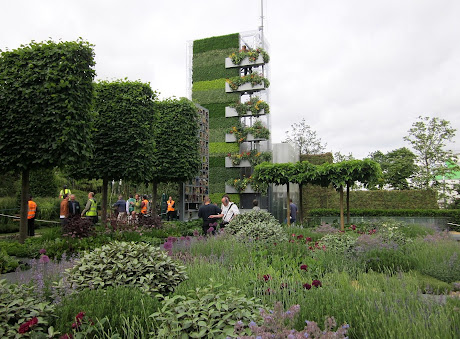The Legacy of Chelsea: Ideas
I was originally going to show you The B&Q Garden as part of a joke: as part of a 'Separated at Birth' picture alongside my original Hanging Gardens of the Barbican.
But whilst I was thinking along those lines and planning what I'd say, I realised that this 'garden' wasn't really about our own plots at all. Instead it's an expression of ideas around the issues surrounding our need to grow more food in a world where land and the other resources required to do so are dwindling. Thus it isn't a joke at all, but something of importance.
The garden is a collaboration between a garden designer and architect and is their response to an estimate that London would run out of food in a mere four days if supplies ceased. It's meant to encourage us all to develop new growing spaces, either as individuals or part of a community initiative. It also encourages urban greening, which was the subject of my other Chelsea legacy post on Monday.
Issues of sustainability are also tackled with the incorporation of rainwater harvesting, a wind turbine and photovoltaic cells. The planting (especially with the lavish provision of herbs) was designed to encourage wildlife in addition to the massive insect hotel made by local schoolchildren.
It's also saying we've got to be more innovative in our growing spaces, perhaps needing to think vertically as well as gardening in more conventional ways. Of course having a green wall isn't a new concept (and there were plenty on show in other gardens at Chelsea), but in my view it has still to be translated successfully into a solution that's cheap, easy to install and maintain.
To me that's the true value of a show garden like this one. It may only be around for 6 days (and might not itself have been a truly sustainable solution), but I'm sure it'll inspire plenty of designers and companies to start thinking about the ideas encompassed in this garden and how they can be achieved as a year-round prospect. They will then come up with the more practical ways and provide the products to help us to do so. It's a bit like that scene in The Devil Wears Prada, when Meryl Streep explains to Anne Hathaway how something seen on the catwalk gets progressively filtered down to the high street shops.
In the meantime as much of this garden as possible will be recycled and used in London's Capital Growth initiative.











You make a very good point about designs and designers, though the one I remember at Canada Blooms that consisted of Granny Smith apples all over the ground, apple-green guazy curtains and a disco-ball? I can't find anything practical filtering out of that one, can you?
ReplyDeleteHmm tricky, but you could make something with all those Granny Smith apples - pie anyone?
ReplyDeleteI also hear disco balls are the next must have garden accessory ;)
There is another Chelsea scheme now in it's second year run by LCRN and Growing Southwark-
ReplyDeleteThe aim of the scheme is to capture the material used by the exhibiting gardens and redistribute it to community growing projects in need.
http://www.lcrn.org.uk/news/1525#chelsea
Very exciting me thinks!
Cheers
You are correct thatthe garden encourages communities to develop new sustainable growing spaces. Two other highlights of this garden were the insect hotels designed by school children and the ability for the public to interact somewhat with the garden by allowing the public to touch and smell the herbs--very rare for a chelsea garden!
ReplyDeleteI also posted on the Chelsea show. Hope you'll take a look.
http://thlandscapedesign.blogspot.com/
Alas, another May come and gone without me getting to the Chelsea Flower Show :(
ReplyDelete30foxley - ooh thanks for letting me know - it looks a very good project indeed!
ReplyDeleteTH - it's been interesting to see how the insect hotel first shown in Nigel Dunnet's show garden 2 years ago was reprised in last year's biodiversity exhibit in Chelsea's Great Pavilion and 'went large' this year.
Helen - shame. I hope you get there sometime...